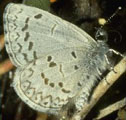Doug Tallamy mentioned this as a highly beneficial plant to put in if you’re wanting to help insects, birds, and other wildlife. It’s native in many states and offers year round interest in the garden. I was happy to find one at this year’s NCBG plant sale, though I wasn’t sure if it would go in Poplar Folly or the bird haven garden area.
After being in the bird haven space yesterday I decided that this will go in the very corner of that area where it will have room to round out and create both a screen and mid-height layer in this garden space. From the street side it will be behind the southern bayberries that are outside our front fence, and to the right of a lovely redbud that sits just outside the corner.
From inside the bird haven area, it will be at the top corner, with hearts a bustin’ and southern shield ferns in front of it. In my mind’s eye, it will be perfect. Sometimes my mind’s eye is accurate, and sometimes I don’t quite nail it, but I’m going to give this a try.
More on this lovely shrub:
Viburnum dentatum
Viburnum dentatum L.
Southern Arrowwood
Caprifoliaceae (Honeysuckle Family)
Synonym(s):
USDA Symbol: vide
USDA Native Status: L48 (N)
A 6-8 ft. shrub, sometimes taller, with multiple, erect-arching stems in a loose, round habit. White, flat-topped flower clusters are followed by dark blue berries. Lustrous, dark-green foliage turns yellow to wine-red in fall. A shrub with downy twigs, coarsely toothedleaves, and flat-topped clusters of small, white flowers. Some botanists recognize two separate species for this highly variable plant, the other being northern Arrowwood (V. recognitum) with smooth twigs.
Plant Characteristics
Duration: PerennialHabit: Shrub
Leaf Retention: Deciduous
Leaf Arrangement: Opposite
Leaf Complexity: Simple
Leaf Shape: Elliptic , Ovate
Leaf Margin: Serrate
Size Notes: Many branced shrub to 10 feet.
Leaf: Shiny dark green above, pale below.
Autumn Foliage: yes
Flower: Flowers 2-4 inches across.
Fruit: Black, Purple 1/3 inch long.
Size Class: 6-12 ft.
Distribution
USA: AL , AR , CT , DC , DE , FL , GA , IA , IL , IN , KY , LA , MA , MD , ME , MI , MO , MS , NC , NH , NJ , NY , OH , PA , RI , SC , TN , TX , VA , VT , WI , WVCanada: NB , ON
Native Distribution: FL to e. TX, n., especially on the Coastal Plain to MA & OH
Native Habitat: Stream banks; moist woods
Growing Conditions
Light Requirement: Sun , Part Shade , ShadeSoil Moisture: Moist
Soil pH: Acidic (pH<6.8)
Soil Description: Dry to wet, acid soils and sands.
Conditions Comments: Flood, insect and disease tolerant. Suckers freely from base and transplants well. Most soil-adaptable of the viburnums. Pest free.
Benefit
Use Wildlife: Gamebirds, songbirds and small mammals. Attracts Eastern Bluebird, Northern Flicker, Gray Catbird, and American Robin.Conspicuous Flowers: yes
Attracts: Birds , Butterflies
Larval Host: Spring Azure
Value to Beneficial Insects
Special Value to Native BeesSpecial Value to Bumble Bees
Supports Conservation Biological Control
This information was provided by the Pollinator Program at The Xerces Society for Invertebrate Conservation.
Butterflies and Moths of North America (BAMONA)
| Spring Azure (Celastrina "ladon" )  Larval Host |









